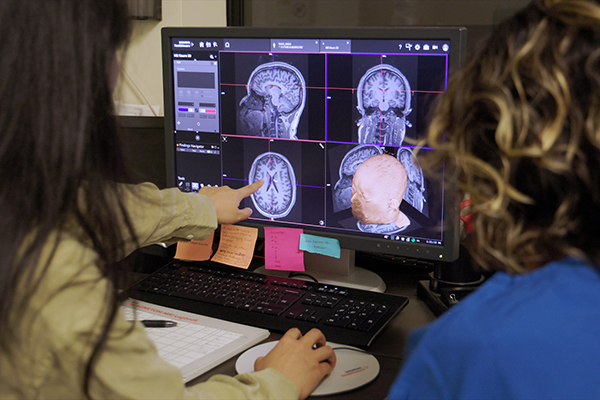Georgia Tech Neuroscientists Explore the Intersection of Music and Memory
Researchers demonstrate music’s impact on learning and memory, with possible therapeutic applications for mental health.

The soundtrack of this story begins with a vaguely recognizable and pleasant groove. But if I stop writing and just listen for a second, the music reveals itself completely. In Freddie Hubbard’s comfortable, lilting trumpet solo over Herbie Hancock’s melodic, repetitive piano vamping, I recognize “Cantaloupe Island.” Then, with my fingers again poised at the keyboard, Freddie and Herbie fade into the background, followed by other instrumental music: captivating — but not distracting — sonic nutrition, feeding my concentration and productivity.
Somewhere, I think, Yiren Ren is studying, focused on her research that demonstrates how music impacts learning and memory. Possibly, she’s listening to Norah Jones, or another musician she’s comfortable with. Because that’s how it works: The music we know and might love, music that feels predictable or even safe — that music can help us study and learn. Meanwhile, Ren has also discovered, other kinds of music can influence our emotions and reshape old memories.
Ren, a sixth-year Ph.D. student in Georgia Tech’s School of Psychology, explores these concepts as the lead author of two new research papers in the journals PLOS One and Cognitive, Affective, & Behavioral Neuroscience (CABN).
“These studies are connected because they both explore innovative applications of music in memory modulation, offering insights for both every day and clinical use,” says Ren.
But the collective research explores music’s impacts in very different ways, explains Ren’s faculty advisor and co-author of the study, Thackery Brown.
“One paper looks at how music changes the quality of your memory when you’re first forming it — it’s about learning,” says Brown, a cognitive neuroscientist who runs the MAP (Memory, Affect, and Planning) Lab at Tech. “But the other study focuses on memories we already have and asks if we can change the emotions attached to them using music.”
Making Moods With Music

When we watch a movie with a robust score — music created to induce emotions — what we’re hearing guides us exactly where the composer wants us to go. In their CABN study, Ren, Brown, and their collaborators from the University of Colorado (including former Georgia Tech Assistant Professor Grace Leslie) report that this kind of “mood music” can also be powerful enough to change how we remember our past.
Their study included 44 Georgia Tech students who listened to film soundtracks while recalling a difficult memory. Ren is quick to point out that this was not a clinical trial, so these participants were not identified as people suffering from mood disorders: “We wanted to start off with a random group of people and see if music has the power to modulate the emotional level of their memories.”
Turns out, it does. The participants listened to movie soundtracks and incorporated new emotions into their memories that matched the mood of the music. And the effect was lasting. A day later, when the participants recalled these same memories — but without musical accompaniment — their emotional tone still matched the tone of the music played the day before.
Positive Mood Film Music
Negative Mood Film Music
“This [research] sheds light on the malleability of memory in response to music, and the powerful role music can play in altering our existing memories.”

The researchers could watch all this happening with fMRI (functional magnetic resonance imaging). They could see the altered brain activity in the study participants, the increased connectivity between the amygdala, where emotions are processed, and other areas of the brain associated with memory and integrating information.
“This sheds light on the malleability of memory in response to music, and the powerful role music can play in altering our existing memories,” says Ren.
Ren is herself a multi-instrumentalist who originally planned on being a professional musician. As an undergraduate at Boston University, she pursued a dual major in film production and sound design, and psychology.
She found a way to combine her interests in music and neuroscience and is interested in how music therapy can be designed to help people with mood disorders like post-traumatic stress disorder (PTSD) or depression, “particularly in cases where someone might overexaggerate the negative components of a memory,” Ren says.
There is no time machine that will allow us to go back and insert happy music into the mix while a bad event is happening and a memory is being formed, “but we can retrieve old memories while listening to affective music,” says Brown. “And perhaps we can help people shift their feelings and reshape the emotional tone attached to certain memories.”
Embracing the Familiar
The second study asks a couple of old questions: Should we listen to music while we work or study? And if so, are there more beneficial types of music than others? The answer to both questions might lie, at least partially, within the expansive parameters of personal taste. But even so, there are limits.
Think back to my description of “Cantaloupe Island” at the beginning of this story and how a familiar old jazz standard helped keep this writer’s brain and fingers moving. In the same way, Norah Jones helps Ren when she’s working on new research around music and memory. But if, for some reason, I wanted to test my concentration, I’d play a different kind of jazz, maybe 1950s bebop with its frenetic pace and off-center tone, or possibly a chorus of screeching cats. Same effect. It would demand my attention, and no work would get done.
For this study, Ren combined her gifts as a musician and composer with her research interests in examining whether music can improve — or impair — our ability to learn or remember new information. “We wanted to probe music’s potential as a mnemonic device that helps us remember information more easily,” she says. (An example of a mnemonic device is “Every Good Boy Does Fine,” which stands for E-G-B-D-F and helps new piano players learn the order of notes on a keyboard.)
This study’s 48 participants were asked to learn sequences of abstract shapes while listening to different types of music. Ren played a piece of music, in a traditional or familiar pattern of tone, rhythm, and melody. She then played the exact same set of notes, but out of order, giving the piece an atonal structure.
Familiar, Regular Music
Irregular Music
When they listened to familiar, predictable music, participants learned and remembered the sequences of shapes quicker as their brains created a structured framework, or scaffold, for the new information. Meanwhile, music that was familiar but irregular (think of this writer and the bebop example) made it harder for participants to learn.
“Depending its familiarity and structure, music can help or hinder our memory,” says Ren, who wants to deepen her focus on the neural mechanisms through which music influences human behavior.
She plans to finish her Ph.D. studies this December and is seeking postdoctoral research positions that will allow her to continue the work she’s started at Georgia Tech. Building on that, Ren wants to develop music-based therapies for conditions like depression or PTSD, while also exploring new rehabilitation strategies for aging populations and individuals with dementia.
“These early studies reveal that music can both help and hinder our memory, depending on its familiarity and structure,” Ren says. “I’m excited to bring together my lifelong love of music with my interest in human memory. Because I think the next phase of my research could provide valuable evidence to support the development of music-based interventions for mental health and cognitive function.”
Here's a selection of music that neuroscientist Yiren Ren listens to while focusing on her research.

Citation: Yiren Ren, Sophia Kaltsouni Mehdizadeh, Grace Leslie, Thackery Brown. “Affective music during episodic memory recollection modulates subsequent false emotional memory traces: an fMRI study.” Cognitive, Affective, & Behavioral Neuroscience (June 2024).
doi.org/10.3758/s13415-024-01200-0
Citation: Yiren Ren, Grace Leslie, Thackery Brown. “Visual Sequence Encoding is Modulated by Music Schematic Structure and Familiarity.” PLOS One (August 2024).
doi.org/10.1371/journal.pone.0306271
Note: The researchers and storytelling team would like to thank both the School of Music and the Georgia State/Georgia Tech Center for Advanced Brain Imaging for the use of their facilities to make the video and capture images.
Writer: Jerry Grillo
Media Contact: Shelley Wunder-Smith | shelley.wunder-smith@research.gatech.edu
Video: Christopher McKenney






